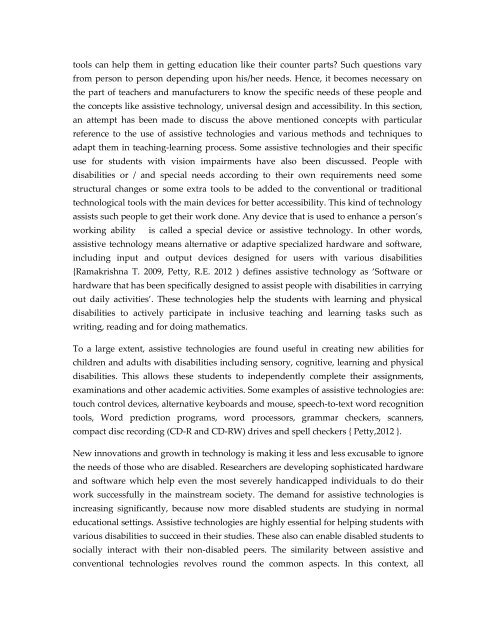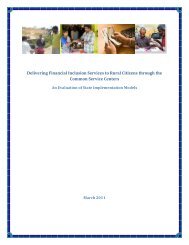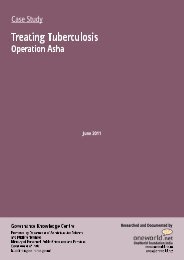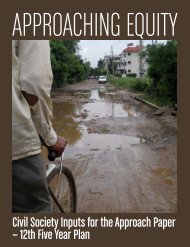Assistive technologies and the education system in India
Assistive technologies and the education system in India
Assistive technologies and the education system in India
You also want an ePaper? Increase the reach of your titles
YUMPU automatically turns print PDFs into web optimized ePapers that Google loves.
tools can help <strong>the</strong>m <strong>in</strong> gett<strong>in</strong>g <strong>education</strong> like <strong>the</strong>ir counter parts? Such questions varyfrom person to person depend<strong>in</strong>g upon his/her needs. Hence, it becomes necessary on<strong>the</strong> part of teachers <strong>and</strong> manufacturers to know <strong>the</strong> specific needs of <strong>the</strong>se people <strong>and</strong><strong>the</strong> concepts like assistive technology, universal design <strong>and</strong> accessibility. In this section,an attempt has been made to discuss <strong>the</strong> above mentioned concepts with particularreference to <strong>the</strong> use of assistive <strong>technologies</strong> <strong>and</strong> various methods <strong>and</strong> techniques toadapt <strong>the</strong>m <strong>in</strong> teach<strong>in</strong>g-learn<strong>in</strong>g process. Some assistive <strong>technologies</strong> <strong>and</strong> <strong>the</strong>ir specificuse for students with vision impairments have also been discussed. People withdisabilities or / <strong>and</strong> special needs accord<strong>in</strong>g to <strong>the</strong>ir own requirements need somestructural changes or some extra tools to be added to <strong>the</strong> conventional or traditionaltechnological tools with <strong>the</strong> ma<strong>in</strong> devices for better accessibility. This k<strong>in</strong>d of technologyassists such people to get <strong>the</strong>ir work done. Any device that is used to enhance a person’swork<strong>in</strong>g ability is called a special device or assistive technology. In o<strong>the</strong>r words,assistive technology means alternative or adaptive specialized hardware <strong>and</strong> software,<strong>in</strong>clud<strong>in</strong>g <strong>in</strong>put <strong>and</strong> output devices designed for users with various disabilities{Ramakrishna T. 2009, Petty, R.E. 2012 ) def<strong>in</strong>es assistive technology as ‘Software orhardware that has been specifically designed to assist people with disabilities <strong>in</strong> carry<strong>in</strong>gout daily activities’. These <strong>technologies</strong> help <strong>the</strong> students with learn<strong>in</strong>g <strong>and</strong> physicaldisabilities to actively participate <strong>in</strong> <strong>in</strong>clusive teach<strong>in</strong>g <strong>and</strong> learn<strong>in</strong>g tasks such aswrit<strong>in</strong>g, read<strong>in</strong>g <strong>and</strong> for do<strong>in</strong>g ma<strong>the</strong>matics.To a large extent, assistive <strong>technologies</strong> are found useful <strong>in</strong> creat<strong>in</strong>g new abilities forchildren <strong>and</strong> adults with disabilities <strong>in</strong>clud<strong>in</strong>g sensory, cognitive, learn<strong>in</strong>g <strong>and</strong> physicaldisabilities. This allows <strong>the</strong>se students to <strong>in</strong>dependently complete <strong>the</strong>ir assignments,exam<strong>in</strong>ations <strong>and</strong> o<strong>the</strong>r academic activities. Some examples of assistive <strong>technologies</strong> are:touch control devices, alternative keyboards <strong>and</strong> mouse, speech-to-text word recognitiontools, Word prediction programs, word processors, grammar checkers, scanners,compact disc record<strong>in</strong>g (CD-R <strong>and</strong> CD-RW) drives <strong>and</strong> spell checkers { Petty,2012 }.New <strong>in</strong>novations <strong>and</strong> growth <strong>in</strong> technology is mak<strong>in</strong>g it less <strong>and</strong> less excusable to ignore<strong>the</strong> needs of those who are disabled. Researchers are develop<strong>in</strong>g sophisticated hardware<strong>and</strong> software which help even <strong>the</strong> most severely h<strong>and</strong>icapped <strong>in</strong>dividuals to do <strong>the</strong>irwork successfully <strong>in</strong> <strong>the</strong> ma<strong>in</strong>stream society. The dem<strong>and</strong> for assistive <strong>technologies</strong> is<strong>in</strong>creas<strong>in</strong>g significantly, because now more disabled students are study<strong>in</strong>g <strong>in</strong> normal<strong>education</strong>al sett<strong>in</strong>gs. <strong>Assistive</strong> <strong>technologies</strong> are highly essential for help<strong>in</strong>g students withvarious disabilities to succeed <strong>in</strong> <strong>the</strong>ir studies. These also can enable disabled students tosocially <strong>in</strong>teract with <strong>the</strong>ir non-disabled peers. The similarity between assistive <strong>and</strong>conventional <strong>technologies</strong> revolves round <strong>the</strong> common aspects. In this context, all
















